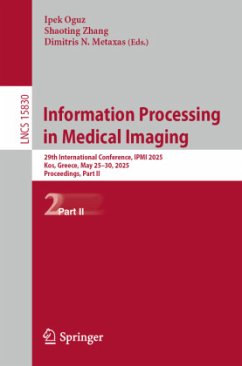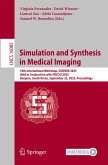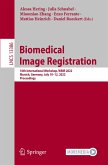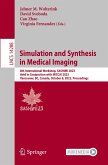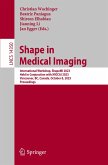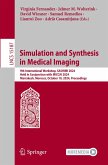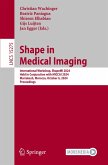Information Processing in Medical Imaging
29th International Conference, IPMI 2025, Kos, Greece, May 25-30, 2025, Proceedings, Part II
Herausgegeben:Oguz, Ipek; Zhang, Shaoting; Metaxas, Dimitris N.
Information Processing in Medical Imaging
29th International Conference, IPMI 2025, Kos, Greece, May 25-30, 2025, Proceedings, Part II
Herausgegeben:Oguz, Ipek; Zhang, Shaoting; Metaxas, Dimitris N.
- Broschiertes Buch
- Merkliste
- Auf die Merkliste
- Bewerten Bewerten
- Teilen
- Produkt teilen
- Produkterinnerung
- Produkterinnerung
This two-volume set LNCS 15829-15830 constitutes the proceedings of the 29th International Conference on Information Processing in Medical Imaging, IPMI 2025, held on Kos, Greece, during May 25-30, 2025.
The 51 full papers presented in this volume were carefully reviewed and selected from 143 submissions. They were organized in topical sections as follows: Part I: Classification/Detection; Registration; Reconstruction; Image synthesis; Image enhancement; and Segmentation. Part II: Computer-aided diagnosis/surgery; Brain; Diffusion models; Self-supervised learning; Vision-language models; Shape analysis; and Time-series image analysis. …mehr
Andere Kunden interessierten sich auch für
![Information Processing in Medical Imaging Information Processing in Medical Imaging]() Information Processing in Medical Imaging56,99 €
Information Processing in Medical Imaging56,99 €![Simulation and Synthesis in Medical Imaging Simulation and Synthesis in Medical Imaging]() Simulation and Synthesis in Medical Imaging44,99 €
Simulation and Synthesis in Medical Imaging44,99 €![Biomedical Image Registration Biomedical Image Registration]() Biomedical Image Registration53,99 €
Biomedical Image Registration53,99 €![Simulation and Synthesis in Medical Imaging Simulation and Synthesis in Medical Imaging]() Simulation and Synthesis in Medical Imaging42,99 €
Simulation and Synthesis in Medical Imaging42,99 €![Shape in Medical Imaging Shape in Medical Imaging]() Shape in Medical Imaging57,99 €
Shape in Medical Imaging57,99 €![Simulation and Synthesis in Medical Imaging Simulation and Synthesis in Medical Imaging]() Simulation and Synthesis in Medical Imaging44,99 €
Simulation and Synthesis in Medical Imaging44,99 €![Shape in Medical Imaging Shape in Medical Imaging]() Shape in Medical Imaging44,99 €
Shape in Medical Imaging44,99 €-
-
-
This two-volume set LNCS 15829-15830 constitutes the proceedings of the 29th International Conference on Information Processing in Medical Imaging, IPMI 2025, held on Kos, Greece, during May 25-30, 2025.
The 51 full papers presented in this volume were carefully reviewed and selected from 143 submissions. They were organized in topical sections as follows:
Part I: Classification/Detection; Registration; Reconstruction; Image synthesis; Image enhancement; and Segmentation.
Part II: Computer-aided diagnosis/surgery; Brain; Diffusion models; Self-supervised learning; Vision-language models; Shape analysis; and Time-series image analysis.
The 51 full papers presented in this volume were carefully reviewed and selected from 143 submissions. They were organized in topical sections as follows:
Part I: Classification/Detection; Registration; Reconstruction; Image synthesis; Image enhancement; and Segmentation.
Part II: Computer-aided diagnosis/surgery; Brain; Diffusion models; Self-supervised learning; Vision-language models; Shape analysis; and Time-series image analysis.
Produktdetails
- Produktdetails
- Lecture Notes in Computer Science 15830
- Verlag: Springer / Springer Nature Switzerland / Springer, Berlin
- Artikelnr. des Verlages: 978-3-031-96624-8
- Seitenzahl: 428
- Erscheinungstermin: 7. August 2025
- Englisch
- Abmessung: 235mm x 155mm x 24mm
- Gewicht: 645g
- ISBN-13: 9783031966248
- ISBN-10: 3031966244
- Artikelnr.: 74212377
- Herstellerkennzeichnung
- Springer-Verlag GmbH
- Tiergartenstr. 17
- 69121 Heidelberg
- ProductSafety@springernature.com
- Lecture Notes in Computer Science 15830
- Verlag: Springer / Springer Nature Switzerland / Springer, Berlin
- Artikelnr. des Verlages: 978-3-031-96624-8
- Seitenzahl: 428
- Erscheinungstermin: 7. August 2025
- Englisch
- Abmessung: 235mm x 155mm x 24mm
- Gewicht: 645g
- ISBN-13: 9783031966248
- ISBN-10: 3031966244
- Artikelnr.: 74212377
- Herstellerkennzeichnung
- Springer-Verlag GmbH
- Tiergartenstr. 17
- 69121 Heidelberg
- ProductSafety@springernature.com
Computer-aided diagnosis/surgery: Concepts from Neurons: Building Interpretable Medical Image Diagnostic Models by Dissecting Opaque Neural Networks.- BioSonix: Can Physics-based Sonification Perceptualize Tissue Deformations from Tool Interactions? Brain: Explainable Deep Model for Understanding Neuropathological Events Through Neural Symbolic Regression.- A Multi-Layer Neural Transport Model for Characterizing Pathology Propagation in Neurodegenerative Diseases.- Enhancing Alzheimer's Diagnosis: Leveraging Anatomical Landmarks in Graph Convolutional Neural Networks on Tetrahedral Meshes.- Hierarchical Variable Importance with Statistical Control for Medical Data-Based Prediction.- Disentangle disease-relevant patterns from irrelevant patterns in fMRI analysis using equivariant and contrastive learning. Diffusion models: Continuous Diffusion Model for Self-supervised Denoising and Super-resolution on Fluorescence Microscopy Images.- Self-Supervised Denoising of Diffusion MRI Data with Efficient Collaborative Diffusion Model.- MAD-AD: Masked Diffusion for Unsupervised Brain Anomaly Detection. Self-supervised learning: Taming Masked Image Modeling for Chest X-ray Diagnosis by Incorporating Clinical Visual Priors.- Diffusion MAE: Paving the Way for Representation Learning of Diffusion MRI.- Resolving quantitative MRI model degeneracy in self-supervised machine learning. Vision-language models: Knowledge-enhanced Hyperbolic Language-Image Pretraining for Zero-shot Learning.- Structure Observation Driven Image-Text Contrastive Learning for Computed Tomography Report Generation.- Hierarchical CLIPs for Fine-grained Anatomical Lesion Localization from Whole-body PET/CT Images.- Multi-View and Multi-Scale Alignment for Contrastive Language-Image Pre-training in Mammography.- Interpretable Few-Shot Retinal Disease Diagnosis with Concept-Guided Prompting of Vision-Language Models.- Full Conformal Adaptation of Medical Vision-Language Models.- A Reality Check of Vision-Language Pre-training in Radiology: Have We Progressed Using Text? Shape analysis: ToothForge: Automatic Dental Shape Generation using Synchronized Spectral Embeddings.- LEDA: Log-Euclidean Diffeomorphism Autoencoder for Efficient Statistical Analysis of Diffeomorphisms.- CoRLD: Contrastive Representation Learning of Deformable Shapes in Images. Time-series image analysis: 4DRGS: 4D Radiative Gaussian Splatting for Efficient 3D Vessel Reconstruction from Sparse-View Dynamic DSA Images.- Brightness-Invariant Tracking Estimation in Tagged MRI.- SafeTriage: Facial Video De-identification for Privacy-Preserving Stroke Triage.
Computer-aided diagnosis/surgery: Concepts from Neurons: Building Interpretable Medical Image Diagnostic Models by Dissecting Opaque Neural Networks.- BioSonix: Can Physics-based Sonification Perceptualize Tissue Deformations from Tool Interactions? Brain: Explainable Deep Model for Understanding Neuropathological Events Through Neural Symbolic Regression.- A Multi-Layer Neural Transport Model for Characterizing Pathology Propagation in Neurodegenerative Diseases.- Enhancing Alzheimer's Diagnosis: Leveraging Anatomical Landmarks in Graph Convolutional Neural Networks on Tetrahedral Meshes.- Hierarchical Variable Importance with Statistical Control for Medical Data-Based Prediction.- Disentangle disease-relevant patterns from irrelevant patterns in fMRI analysis using equivariant and contrastive learning. Diffusion models: Continuous Diffusion Model for Self-supervised Denoising and Super-resolution on Fluorescence Microscopy Images.- Self-Supervised Denoising of Diffusion MRI Data with Efficient Collaborative Diffusion Model.- MAD-AD: Masked Diffusion for Unsupervised Brain Anomaly Detection. Self-supervised learning: Taming Masked Image Modeling for Chest X-ray Diagnosis by Incorporating Clinical Visual Priors.- Diffusion MAE: Paving the Way for Representation Learning of Diffusion MRI.- Resolving quantitative MRI model degeneracy in self-supervised machine learning. Vision-language models: Knowledge-enhanced Hyperbolic Language-Image Pretraining for Zero-shot Learning.- Structure Observation Driven Image-Text Contrastive Learning for Computed Tomography Report Generation.- Hierarchical CLIPs for Fine-grained Anatomical Lesion Localization from Whole-body PET/CT Images.- Multi-View and Multi-Scale Alignment for Contrastive Language-Image Pre-training in Mammography.- Interpretable Few-Shot Retinal Disease Diagnosis with Concept-Guided Prompting of Vision-Language Models.- Full Conformal Adaptation of Medical Vision-Language Models.- A Reality Check of Vision-Language Pre-training in Radiology: Have We Progressed Using Text? Shape analysis: ToothForge: Automatic Dental Shape Generation using Synchronized Spectral Embeddings.- LEDA: Log-Euclidean Diffeomorphism Autoencoder for Efficient Statistical Analysis of Diffeomorphisms.- CoRLD: Contrastive Representation Learning of Deformable Shapes in Images. Time-series image analysis: 4DRGS: 4D Radiative Gaussian Splatting for Efficient 3D Vessel Reconstruction from Sparse-View Dynamic DSA Images.- Brightness-Invariant Tracking Estimation in Tagged MRI.- SafeTriage: Facial Video De-identification for Privacy-Preserving Stroke Triage.

